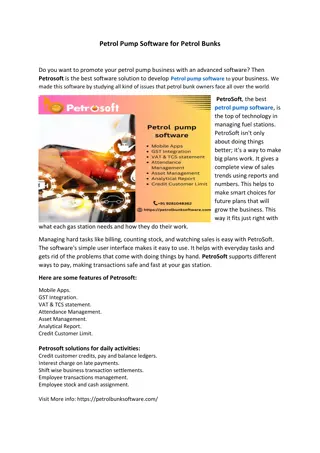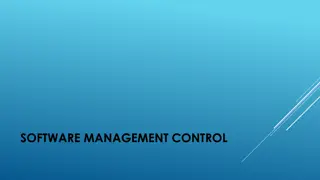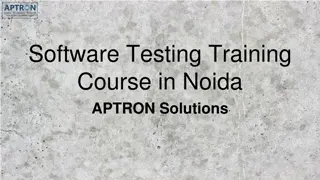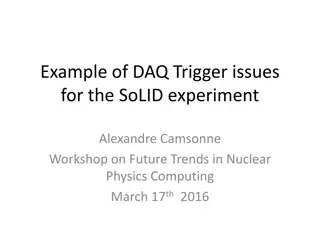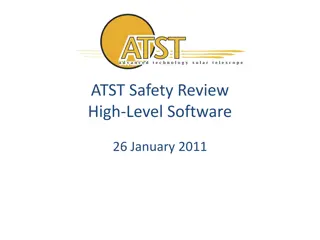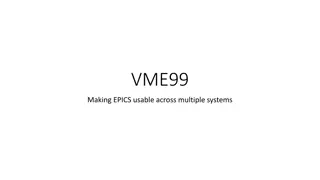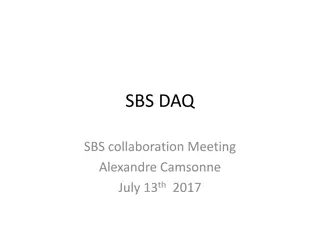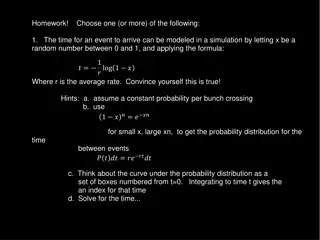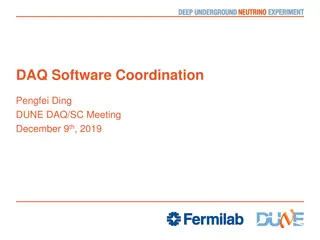
Medium-Size Data Acquisition System: Components and Software Overview
Explore the components and software concepts of a medium-size Data Acquisition System, including trigger management, data read-out, event framing, system control, and monitoring. Discover the technical foundations for building larger systems using pseudo-code and understand the process of data sampling and transmission. Get insights into a multi-crate system's structure and functionality for efficient data management.
Download Presentation

Please find below an Image/Link to download the presentation.
The content on the website is provided AS IS for your information and personal use only. It may not be sold, licensed, or shared on other websites without obtaining consent from the author. If you encounter any issues during the download, it is possible that the publisher has removed the file from their server.
You are allowed to download the files provided on this website for personal or commercial use, subject to the condition that they are used lawfully. All files are the property of their respective owners.
The content on the website is provided AS IS for your information and personal use only. It may not be sold, licensed, or shared on other websites without obtaining consent from the author.
E N D
Presentation Transcript
Overview Aim of this lecture is Give an overview of a medium-size DAQ Analyze its components Introduce the main concepts of DAQ software As bricks to build larger system with the help of some pseudo-code Give more technical basis For the implementation of larger systems Oct. 12, 2023 E. Pasqualucci 1
A multi-crate system Detector readout Trigger Modular electronics= Trigger Detector 1 Trigger Detector N T r i g g e r T r i g g e r Configuration Configuration . . . Online monitoring C P U A D C C P U A D C A D C T D C A D C T D C T D C T D C Trigger Trigger Readout Readout VME (or ) crate Network Monitoring system Run Control Event Flow Manager . . . E B E B (M) (1) Storage Oct. 12, 2023 E. Pasqualucci 2
Software components Trigger management Data read-out Event framing and buffering Data transmission Event building and data storage System control and monitoring Data sampling and monitoring Oct. 12, 2023 E. Pasqualucci 3
A multi-crate system Trigger Detector 1 Trigger Detector N T r i g g e r T r i g g e r Configuration Configuration . . . Online monitoring C P U A D C C P U A D C A D C T D C A D C T D C T D C T D C Trigger Trigger Readout Readout Run Control Event Flow Manager . . . E B E B (M) (1) Oct. 12, 2023 E. Pasqualucci 4
Data readout (a simple example) Detector Trigger T r i g g e r Configuration C P U A D C A D C T D C T D C Trigger Readout Data digitized by VME modules (ADC and TDC) Trigger signal received by a trigger module I/O register or interrupt generator Data read-out by a Single Board Computer (SBC) Oct. 12, 2023 E. Pasqualucci 5
Trigger management How to know that new data is available? Interrupt An interrupt is sent by a hardware device The interrupt is Transformed into a software signal Caught by a data acquisition program Undetermined latency is a potential problem! Data readout starts Polling Some register in a module is continuously read out Data readout happens when register signals new data In a synchronous system (the simplest one ) Trigger must also set a busy The reader must reset the busy after read-out completion Oct. 12, 2023 E. Pasqualucci 6
Real time programming Must meet operational deadlines from events to system response Implies taking control of typical OS tasks For instance, task scheduling Real time OSs offer that features Most important feature is predictability Performance is less important than predictability! It typically applies when requirements are Reaction time to an interrupt within a certain time interval Complete control of the interplay between applications Oct. 12, 2023 E. Pasqualucci 7
Is real-time needed? Can be essential in some case May be critical for accelerator control or plasma control Wherever event reaction times are critical And possibly complex calculation is needed Not commonly used for data acquisition now Large systems are normally asynchronous Either events are buffered and de-randomized in the HW Performance is usually improved by DMA readout (see M. Joos) Or the main dataflow does not pass through the bus In a small system dead time is normally small Drawbacks We loose complete dead time control Event reaction time and process scheduling are left to the OS Increase of latency due to event buffering Affects the buffer size at event building level Normally not a problem in modern DAQ systems Oct. 12, 2023 E. Pasqualucci 8
Polling modules Loop reading a register containing the latched trigger while (end_loop == 0) { uint16_t *pointer; volatile uint16_t trigger; pointer = (uint16_t *) (base + 0x80); trigger = *pointer; if (trigger & 0x200) // look for a bit in the trigger mask { ... Read event ... ... Remove busy ... } else sched_yield (); // if in a multi-process/thread environment } Oct. 12, 2023 E. Pasqualucci 9
Polling or interrupt? Which method is convenient? It depends on the event rate Interrupt Is expensive in terms of response time Typically (O (1 s)) Convenient for events at low rate Avoid continuous checks A board can signal internal errors via interrupts Polling Convenient for events at high rate When the probability of finding an event ready is high Does not affect others if scheduler is properly released Can be calibrated dynamically with event rate If the input is de-randomized Oct. 12, 2023 E. Pasqualucci 10
The simplest DAQ Synchronous readout: The trigger is Auto-vetoed (a busy is asserted by trigger itself) Explicitly re-enabled after data readout Additional dead time is generated by the output // VME interrupt is mapped to SYSUSR1 event_loop () { while (end_loop == 0) { if (event) { size += read_data (*p); write (fd, ptr, size); busy_reset (); event = FALSE; } } } static int event = FALSE; const int event_available = SIGUSR1; // Signal Handler void sig_handler (int s) { if (s == event_available) event = TRUE; } Oct. 12, 2023 E. Pasqualucci 11
Fragment buffering Why buffering? Triggers are uncorrelated Create internal de-randomizers Minimize dead time See Andrea s lecture Optimize the usage of output channels Disk Network Avoid back-pressure due to bursts in data rate Warning! Avoid copies as much as possible Copying memory chunks is an expensive operation Only move pointers! Oct. 12, 2023 E. Pasqualucci 12
A simple example Ring buffers emulate FIFO A buffer is created in memory Shared memory can be requested to the operating system A master creates/destroys the memory and a semaphore A slave attaches/detaches the memory Packets ( events ) are Written to the buffer by a writer Read-out by a reader Works in multi-process and multi-thread environment Essential point Avoid multiple copies! If possible, build events directly in buffer memory Oct. 12, 2023 E. Pasqualucci 13
Ring buffer head ceiling ceiling tail tail head head head head head The two processes/threads can run concurrently Header protection is enough to insure event protection A library can take care of buffer management A simple API is important We introduced Shared memories provided by OS Buffer protection (semaphores or mutexes) Buffer and packed headers (managed by the library) Unprotect pointers Writer: Reserve a chunk of memory: Build event frame and calculate (max) size Protect pointers Move the head Write the packet header Set the packet as FILLING Reader: Release Protect pointers Move tail Unprotect pointers Set event status to EMPTYING Complete the event frame Reader: Work on data Reader: Locate next available buffer: Protect pointers Get oldest event (if any) Write data to the buffer Writer: Validate the event: Protect the buffer Set the packet as READY (Move the head to correct value) Unprotect the buffer Unprotect pointers Writer: Build the event fragment in memory: Prepare event header struct header { int head; int tail; int ceiling; } Oct. 12, 2023 E. Pasqualucci 14
Event buffering example Data collector Data writer int cid = CircOpen (NULL, Circ_key, size)); while (end_loop == 0) { if (event) { int maxsize = 512; char *ptr; uint32_t *p; uint32_t *words; int number = 0, size = 0; int fd, cid; fd = open (pathname, O_WRONLY | O_CREAT); cid = CircOpen (NULL, key, 0)); while (end_loop == 0) { char *ptr; while ((ptr = CircReserve (cid, number, maxsize)) == (char *) -1) sched_yield (); if ((ptr = CircLocate (cid, &number, &evtsize)) > (char *) 0) { write (fd, ptr, evtsize); CircRelease (cid); } p = (int *) ptr; *p++ = crate_number; ++size; *p++; words = p; ++size; size += read_data (*p); *words = size; CircValidate (cid, number, ptr, size * sizeof (uint32_t)); ++number; sched_yield (); } CircClose (cid); close (fd); busy_reset (); event = FALSE; } sched_yield (); } CircClose (cid); Find next event Write to the output and release the buffer Read data and put them directly into the buffer Prepare the header Reserve the buffer (maximum event size) Set TRUE by a signal handler upon trigger arrival Open the buffer in master mode Validate the buffer Reset the busy Release the scheduler Close the buffer E. Pasqualucci Release the scheduler Oct. 12, 2023 15
By the way In these examples we were Polling for events in a buffer Polling for buffer descriptor pointers in a queue We could have used Signals to communicate that events were available Handlers to catch signals and start buffer readout If a buffer gets full Because: The output link throughput is too small There is a large peak in data rate The buffer gets busy and generates back-pressure Thresholds must be set to accommodate events generated during busy transmission when redirecting data flow These concepts are very general Oct. 12, 2023 E. Pasqualucci 16
Event framing Fragment header/trailer Identify fragments and characteristics Useful for subsequent DAQ processes Event builder and online monitoring tasks Fragment origin is easily identified Can help in identifying sources of problems Can (should) contain a trigger ID for event building Can (should) contain a status word Global event frame Give global information on the event Very important in networking Though you do not see that See networking lecture Oct. 12, 2023 E. Pasqualucci 17
Framing example typedef struct { u_int startOfHeaderMarker; u_int totalFragmentsize; u_int headerSize; u_int formatVersionNumber; u_int sourceIdentifier; u_int numberOfStatusElements; } GenericHeader; Header Status words Event Payload Oct. 12, 2023 E. Pasqualucci 18
What can we do now. We are now able to Build a readout (set of) application(s) with An input thread (process) An output thread (process) A de-randomizing buffer Let s elaborate a bit Oct. 12, 2023 E. Pasqualucci 19
A more general buffer manager Same basic idea Use a pre-allocated memory pool to pass events Paged memory Can be used to minimize pointer arithmetic Convenient if event sizes are comparable At the price of some memory Buffer descriptors Built in an on-purpose pre-allocate memory Pointers to descriptors are queued Allows any number of input and output threads Oct. 12, 2023 E. Pasqualucci 20
A paged memory pool Reserve memory Writer Reader Queue (or vector) Oct. 12, 2023 E. Pasqualucci 21
Generic readout application Module Input Handler Oct. 12, 2023 E. Pasqualucci 22
Configurable applications Ambitious idea Support all the systems with a single application Through plug-in mechanism Requires a configuration mechanism You will (not) see an example in exercise 4 Oct. 12, 2023 E. Pasqualucci 23
Some basic components We introduced basic elements of IPC Signals and signal catching Shared memories Semaphores (or mutexes) Message queues and some standard DAQ concepts Trigger management, busy, back-pressure Synchronous vs asynchronous systems Polling vs interrupts Real time programming Event framing Memory management Oct. 12, 2023 E. Pasqualucci 24
A multi-crate system again Trigger Detector 1 Trigger Detector N T r i g g e r T r i g g e r Configuration Configuration . . . Online monitoring C P U A D C C P U A D C A D C T D C A D C T D C T D C T D C Trigger Trigger Readout Readout Run Control Event Flow Manager . . . E B E B (M) (1) Oct. 12, 2023 E. Pasqualucci 25
Event building Large detectors Sub-detectors data are collected independently Readout network Fast data links Events assembled by event builders From corresponding fragments Custom devices used In FEE In low-level triggers COTS used In high-level triggers In event builder network DAQ system data flow & control distributed & asynchronous Detector Frontend Level 1 Trigger Readout Systems Event Manager Controls Builder Networks Filter Systems Computing Services Oct. 12, 2023 E. Pasqualucci 26
Data networks and protocols Data transmission Fragments need to be sent to the event builders One or more Usually done via switched networks User-level protocols Provide an abstract layer for data transmission so you can ignore the hardware you are using and the optimizations made in the OS (well, that s not always true) See the lecture and exercise on networking Most commonly used TCP/IP suite UDP (User Datagram Protocol) Connection-less TCP (Transmission Control Protocol) Connection-based protocol Implements acknowledgment and re-transmission Oct. 12, 2023 E. Pasqualucci 27
TCP client/server example struct sockaddr_in sinme; sinme.sin_family = AF_INET; sinme.sin_addr.s_addr = INADDR_ANY; sinme.sin_port = htons(ask_var->port); struct sockaddr_in sinhim; sinhim.sin_family = AF_INET; sinhim.sin_addr.s_addr = inet_addr (this_host); sinhim.sin_port = htons (port); fd = socket (AF_INET, SOCK_STREAM, 0); bind (fd0, (struct sockaddr *) &sinme, sizeof(sinme)); listen (fd0, 5); if (fd = socket (AF_INET, SOCK_STREAM, 0) < 0) { ; // Error ! } if (connect (fd, (struct sockaddr *)&sinhim, sizeof (sinhim)) < 0) { ; // Error ! } while (n < ns) { // we expect ns connections int val = sizeof(this->sinhim); if ((fd = accept (fd0, (struct sockaddr *) &sinhim, &val)) >0) { FD_SET (fd, &fds); ++ns; } } while (running) { memcpy ((char *) &wait, (char *) &timeout, sizeof (struct timeval)); if ((nsel = select (nfds, 0, &wfds, 0, &wait)) < 0) { ; // Error ! } else if (nsel) { if ((BIT_ISSET (destination, wfds))) { count = write (destination, buf, buflen); // test count // > 0 (has everything been sent ?) // == 0 (error) // < 0 we had an interrupt or // peer closed connection } } } while (running) { if ((nsel = select( nfds, (fd_set *) &fds, 0, 0, &wait)) [ count = read (fd, buf_ptr, buflen); if (count == 0) { close (fd); // set FD bit to 0 } } } close (fd); close (fd0); Oct. 12, 2023 E. Pasqualucci 28
Data transmission optimization When you send data they are copied to a system buffer Data are sent in fixed-size chunks At system level Each endpoint has a buffer to store data that is transmitted over the network TCP stops to send data when available buffer size is 0 Back-pressure With UDP we get data loss If buffer space is too small: Increase system buffer Too large buffers can lead to performance problems Oct. 12, 2023 E. Pasqualucci 29
Controlling the data flow Throughput optimization Avoid dead-time due to back-pressure By avoiding fixed sequences of data destinations Requires knowledge of the EB input buffer state EB architectures Push Events are sent as soon as data are available to the sender The sender knows where to send data The simplest algorithm for distribution is the round-robin Pull Events are required by a given destination processes Needs an event manager Though in principle we could build a pull system without manager Oct. 12, 2023 E. Pasqualucci 30
Pull example Sender Sender Trigger Sender Event Manager Builder network Oct. 12, 2023 E. Pasqualucci 31
Push example Sender Sender Trigger Sender Event Manager Builder network Oct. 12, 2023 E. Pasqualucci 32
System monitoring Two main aspects System operational monitoring Sharing variables through the system Data monitoring Sampling data for monitoring processes Sharing histogram through the system Histogram browsing Oct. 12, 2023 E. Pasqualucci 33
Event sampling examples Spying from buffers Sampling on input or output Spy Writer Writer Reader Reader To monitoring process To monitoring process Sampling is always on the best effort basis and cannot affect data taking Oct. 12, 2023 E. Pasqualucci 34
Histogram and variable distribution Histo Service Sampler Monitoring process Info Service DAQ process Oct. 12, 2023 E. Pasqualucci 35
Histogram browser Oct. 12, 2023 E. Pasqualucci 36
Controlling the system Each DAQ component must have A set of well defined states A set of rules to pass from one state to another Finite State Machine A central process controls the system Run control Implements the state machine Triggers state changes and takes track of components states Trees of controllers can be used to improve scalability A GUI interfaces the user to the Run control and various system services Oct. 12, 2023 E. Pasqualucci 37
GUI example From Atlas Oct. 12, 2023 E. Pasqualucci 38
Finite State Machines Models of the behaviors of a system or a complex object, with a limited number of defined conditions or modes Finite state machines consist of 4 main elements: States which define behavior and may produce actions State transitions which are movements from one state to another Rules or conditions which must be met to allow a state transition Input events which are either externally or internally generated, which may possibly trigger rules and lead to state transitions Recover NONE ERROR Boot Reset BOOTED Configure Unconfigure CONFIGURED Start Stop RUNNING Oct. 12, 2023 E. Pasqualucci 39
Propagating transitions Each component or sub-system is modeled as a FSM The state transition of a component is completed only if all its sub-components completed their own transition State transitions are triggered by commands sent through a message system Final Process Subsystem Control NONE ERROR BOOTED BOOTED NONE ERROR NONE ERROR Run Control CONFIGURED CONFIGURED BOOTED BOOTED BOOTED BOOTED CONFIGURED CONFIGURED CONFIGURED RUNNING CONFIGURED RUNNING RUNNING Oct. 12, 2023 E. Pasqualucci 40
FSM implementation State concept maps on object state concept OO programming is convenient to implement SM State transition Usually implemented as callbacks In response to messages Remember: Each state MUST be well-defined Variables defining the state must have the same values Independently of the state transition Oct. 12, 2023 E. Pasqualucci 41
Message system Networked IPC I will not describe it You see a message system at work in exercise 12 Many possible implementations From simple TCP packets through (rather exotic) SNMP (that s the way many printers are configured ) Very convenient for economic implementation Used in the KLOE experiment to Object Request Browsers (ORB) Used f.i. by ATLAS Oct. 12, 2023 E. Pasqualucci 42
A final remark There is no absolute truth Different systems require different optimizations Different requirements imply different design System parameters must drive the SW design Examples: An EB may use dynamic buffering Though it is expensive If bandwidth is limited by network throughput React to signals or poll Depends on expected event rate Event framing is important But must no be exaggerated Keep it as simple as possible !!!! Oct. 12, 2023 E. Pasqualucci 43
Thanks for your attention! Oct. 12, 2023 E. Pasqualucci 44


